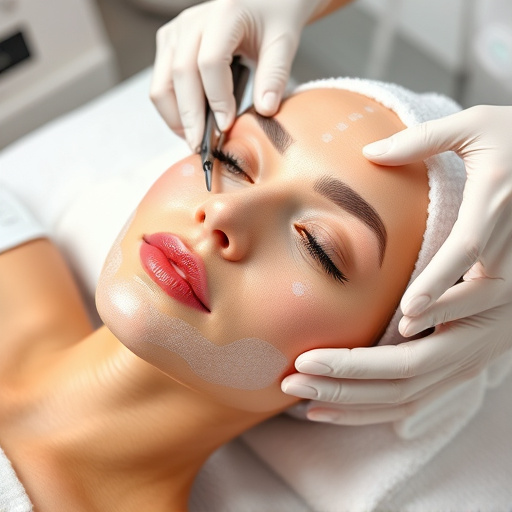Melasma, a hormonal skin condition with dark face patches, is managed through understanding its causes – hormones, sun, medication, genetics. While incurable, diverse melasma treatment options exist: topical meds (hydroquinone, retinoids), chemical peels, microdermabrasion, laser therapy. By 2025, extensive treatments include advanced procedures like microneedling and innovative lasers/light therapy targeting melanin, offering comprehensive solutions for various skin types.
Melasma, characterized by dark patches on the face, remains a common skin concern despite its mysterious etiology. In 2025, understanding melasma’s causes and diagnosis has advanced significantly. This article explores effective treatment options, ranging from topical creams and serums to innovative procedures like lasers and light therapy. We delve into what works best, providing insights for those seeking to restore even skin tone.
- Understanding Melasma: Causes and Diagnosis
- Topical Treatments: Creams and Serums for Even Skin
- Beyond Topicals: Lasers, Light Therapy, and More
Understanding Melasma: Causes and Diagnosis

Melasma is a skin condition characterized by dark, uneven patches on the face, commonly affecting women during or after pregnancy. It’s important to understand its causes and diagnosis to effectively manage it. The primary triggers include hormonal fluctuations, sun exposure, certain medications, and genetics. Melasma treatment options have evolved significantly over the years, offering hope for those struggling with this cosmetic concern.
Diagnosis involves a thorough skin examination by a dermatologist, who may use specialized lighting to observe the condition’s characteristics. While there is no cure, various melasma treatments can help lighten and even out skin tone. These include topical medications like hydroquinone, retinoids, and glycolic acid, which work by inhibiting melanin production or improving skin cell turnover. Additionally, procedures such as chemical peels, microdermabrasion, and laser therapy can provide significant improvements in skin health and appearance for those seeking effective melasma treatment solutions.
Topical Treatments: Creams and Serums for Even Skin

Melasma, characterized by dark patches on the face, has inspired a plethora of treatment options in 2025. Among them, topical treatments have gained significant traction for their ease of use and accessibility. Creams and serums containing active ingredients like hydroquinone, retinoids, and vitamin C are popular choices. These formulations work by inhibiting tyrosinase, the enzyme responsible for melanin production, thereby lightening the dark patches.
Additionally, advanced procedures like microneedling therapy stimulate collagen production to improve skin texture and even out skintone. Chemical peels, another effective melasma treatment, use chemicals to remove the top layer of damaged skin, revealing smoother, brighter underlying skin. These modern approaches, coupled with conventional topical treatments, offer a comprehensive arsenal against melasma, catering to diverse preferences and skin types.
Beyond Topicals: Lasers, Light Therapy, and More

In addition to topical treatments, several innovative therapies have emerged as effective melasma treatment options in recent years. Among them, lasers and light therapy stand out for their ability to target specific skin concerns with precision. Laser hair removal technologies, for instance, utilize focused light energy to break up pigmented spots, promoting gradual skin rejuvenation. These advanced techniques offer a more targeted approach compared to traditional topicals, often delivering faster and more noticeable results.
Furthermore, light therapy, such as intense pulsed light (IPL) treatments, has gained popularity for its multifaceted benefits. IPL works by emitting a broad spectrum of light that targets melanin, helping to reduce the appearance of melasma and improving overall skin health. Combined with other procedures like pore refinement techniques, these advanced melasma treatment options can provide comprehensive solutions, addressing both the visible symptoms and underlying causes of this complex condition.
In 2025, the landscape of melasma treatment offers a variety of effective options. From targeted topical creams and serums to innovative procedures like lasers and light therapy, individuals now have more choices than ever to achieve even, clear skin. Understanding the causes and diagnosis is key, as personalized treatments provide the best results. With ongoing advancements in dermatology, future prospects for melasma management look promising, offering hope for those seeking a radiant, uniform complexion.














